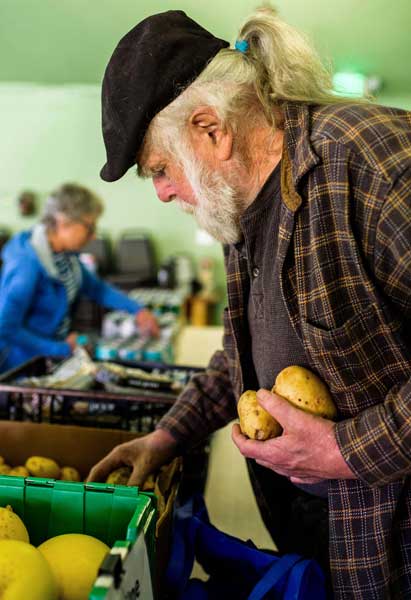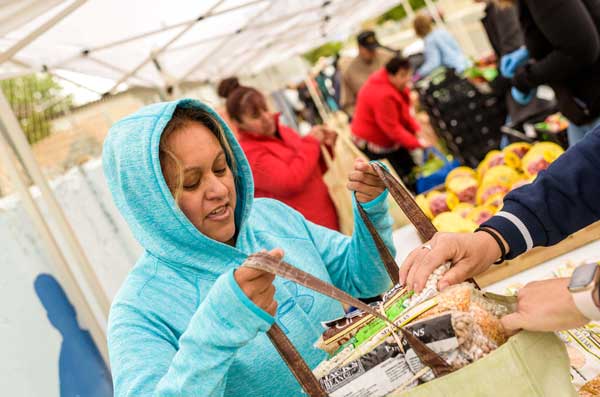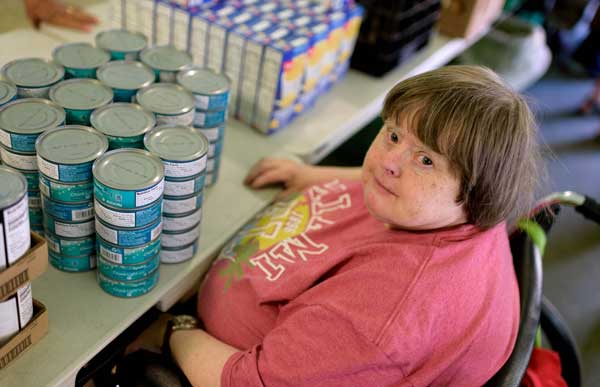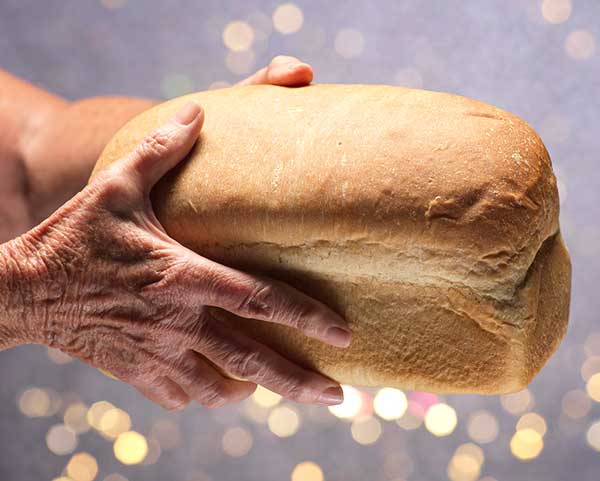HUNGER WARRIORS
A look at the regional food insecurity crisis and who’s combatting it in Reno-Tahoe.
Written by Natasha Bourlin
Photos by Jeff Ross and Candice Vivien
Within its 90,000-square-mile service area, the Food Bank of Northern Nevada in Sparks feeds about 92,000 people monthly. Half of those are children and seniors. Too often, the majority of regional recipients have to choose between food and medical care, or between food and rent. Sometimes the choice is feeding the children while the parents go hungry. Choices such as these shouldn’t have to be made.
Food insecurity is a critical issue in this region — one often shrouded in shame for those in need.
Nonprofit and state-run organizations try to alleviate hunger on a local level, but it’s a complicated process often riddled with bureaucracy. Now, the federal government is attempting to introduce additional barriers to relieving food insecurity both nationally and regionally.
Hunger hot buttons
A heated political topic in 2019 has been the current administration’s efforts to end Supplemental Nutrition Assistance Program benefits for about 3 million people in the United States. SNAP is the largest domestic food distribution source in the country.
American households with gross incomes at or below 130 percent of the poverty line can apply to receive SNAP benefits, which are distributed via an electronic benefit transfer card that can be used to purchase food items at eligible retailers’ registers.

Melledy Hernandez, age 4, picks out some beans at the Food Bank of Northern Nevada’s Mobile Harvest program. Photo by Candice Vivien
According to the U.S. Department of Health and Human Services, the poverty guidelines in 2019 for the 48 contiguous states and the District of Columbia range from $12,490 for a one-person household to $25,750 for a household of four. Consider that an individual working 40 hours a week making minimum wage (a prevalent situation in this service-industry-driven region) will only bring in about $15,000 annually, at most.
Pair that with the current local housing market, in which apartment rent may rival a minimum-wage worker’s monthly income, with little left for other expenses, and you’ll see why the FBNN leaders see a correlation between affordable, available housing in our area and food security.
“We go to clients to find out what’s putting them in a line to need emergency food services, and we hear ‘rising rent and expenses’ every day,” says Jocelyn Lantrip, the FBNN’s director of marketing and communications. “This is an important thing for the community to understand because when unemployment is really low, people think hunger goes away, and it doesn’t; it’s actually really high still. The numbers aren’t going down and that’s why … people just aren’t able to make enough to make ends meet.”
How dire is the situation? Here’s a snapshot, from the U.S. Department of Agriculture’s Food and Nutrition Service program and Feeding America:
- About 33.7 million people were enrolled in the SNAP program nationwide in fiscal year 2019.
- These individuals received an average of $133.54 per month.
- In Nevada, 419,602 individuals were receiving SNAP benefits in June 2019.
- 59,870 people were in need of food in Washoe, Storey, and Churchill counties and Carson City alone in 2017.
Currently, state leaders have some freedom to enroll underserved residents already receiving financial or medical assistance in the SNAP program. While the federal government absorbs the costs of SNAP benefits, states are charged both with determining who is eligible and administering the program.
States typically understand their populations and economic landscapes better than anyone at the federal level, which is why giving them some say over SNAP resource allocation makes sense.
A 2018 report by the USDA’s Economic Research Service states, “An estimated 11.8 percent of American households were food insecure at least some time during the year in 2017, meaning they lacked access to enough food for an active, healthy life for all household members.”
Yet the USDA now is fighting for restrictions on the program.

Zucchini is one of many produce items available through the Food Bank of Northern Nevada’s Mobile Harvest program, which visits neighborhoods across the state to provide food to clients in need. Photo by Candice Vivien
Points of contention
In July, the USDA released a statement that proposed “closing a loophole that allows states to make participants receiving minimal Temporary Assistance for Needy Families (TANF) benefits automatically eligible to participate in the USDA’s SNAP.
“The proposed rule … would limit SNAP/TANF automatic eligibility to households that receive substantial, ongoing TANF-funded benefits aimed at helping families move towards self-sufficiency.”
The administration is concerned that states are bypassing eligibility guidelines, providing SNAP benefits to those who don’t actually need them. Many monitoring requirements, plus a multitude of organizations and individuals — recipients and regulators — are involved in the SNAP program on a state level, which some at the federal level are concerned allows for a great margin of error.
Four elements are the primary causes for governmental concern:
- The trafficking of SNAP benefits, such as trading them for other goods, services, or illicit items.
- Fraudulent applications by retailers to participate in SNAP when they aren’t eligible.
- Application errors or fraud by households, resulting in payments they aren’t eligible to receive.
- State agency mistakes or fraud resulting in payments to ineligible households.
It’s important to note that errors are not the same as intentional fraud.
“In a program that operates with so many different stakeholders, detecting, preventing, and addressing errors and fraud is a complex undertaking,” states a Congressional Research Service report. “Among the complexities are the monitoring of retailer acceptance and recipient use of benefits, the accuracy of information provided by applicant households, and states’ performance administering the program.”
Benefits programs such as SNAP are intended to help people become self-sufficient, escape poverty, or help the elderly and disabled get by when unable to work. A report by the nonprofit research group Urban Institute demonstrates SNAP is doing its job.
“SNAP removed 8.4 million people from poverty in 2015, reducing the poverty rate from 15.4 percent to 12.8 percent (a reduction of 17 percent),” says the report.

Michael Hagerty of Truckee, a volunteer and a recipient of Sierra Community House, picks up food at a distribution center at Truckee Donner Senior Apartments. Photo by Candice Vivien
Life support
As the economy thrives and unemployment rates drop, it’s often presumed that hunger also declines.
While that’s the case in some states, the more likely scenario is one in which employed people with a roofs over their heads and families to feed still cannot fully make ends meet.
The challenge is in finding balance for people near the poverty level. When other necessities are prioritized over food and nutrition, it can have longstanding impacts on individuals left hungry, as well as on the taxpayers who often must absorb the unpaid medical costs that result from hunger.
Malnutrition has repeatedly been shown to affect the health of individuals, in the short and long term. Diabetes, heart disease, and other medical issues often stem from substandard sustenance. The research suggests that alleviating food insecurity today could actually help prevent potential medical issues before they start.
The question many ask is this: Should we spend less on nutrition now, with potentially higher health-care costs down the road, or prioritize access to nutrition and the assistance people need now, and perhaps help them avoid medical issues later in life?
Healthy help
Managers of state-run resources can’t tackle the widespread issue of food insecurity alone. Those running benevolent community organizations are helping hungry Northern Nevadans and Californians become self-sufficient.
In fact, with just some land, even an extra row of vegetables in their garden, people can join the fight against food insecurity.
Much of the food provided to those in need includes processed, shelf-stable items lacking in nutritional value. Fresh produce is a flavorful, healthy treasure — one that a few locals are working to provide to those in need.
Reno-based Soulful Seeds starts community and neighborhood gardens, with its first planted in 2016 on an unused plot behind Saint Mary’s Regional Medical Center. Organization leaders teach the impoverished how to tend to the rows and prepare the produce from them.
Co-founders of the nonprofit Earstin Whitten and wife, Dee Schafer-Whitten, also are working with Northern Nevada HOPES in Reno to build gardens and provide cooking education for vulnerable populations, such as veterans and seniors who will occupy the Hope Springs tiny house project, a Reno community being developed to provide emergency shelter and support services for those in need.
In Carson City, Karen Abowd, a longtime restaurateur and former city supervisor who has mentored high school students, was inspired to start The Greenhouse Project after hearing a heart-wrenching story from one of the freshman students at Carson High School, where the program is based. The girl’s father was incarcerated, her mother had been deported, and she was left to raise her infant brother alone. With no income, she stole formula from a big box store to feed him while she starved.
After hearing that story, Karen and husband Charlie immediately decided to do something.
“I felt it wasn’t right for our community not to be able to take care of each other,” she says.
In 2010, Manhard Consulting/Mark Rotter and Mark Lopiccolo Construction donated their services to build a 2,100-square-foot greenhouse with heaters and coolers for growing year round at Carson High School. The project also provides students an opportunity to learn about the foods they eat, how to grow them, and how they’re helping others through their efforts.
Another was built in 2019 on the Carson Tahoe Regional Medical Center campus. Between November 2013 and July 2019, The Greenhouse Project donated 13,632 pounds of produce to homeless shelters, children and senior homes, and food banks.
Gleaning programs source produce for the hungry from existing orchards and gardens with surplus growth. In Northern California’s lush Nevada County, Sierra Harvest added gleaning to its existing array of food-insecurity-fighting programs 10 years ago, after people with fruit trees and vegetable plots began speaking of all the produce they’d had go to waste.
Connecting that need with another — feeding hungry residents — volunteers now help collect tens of thousands of pounds of donated produce annually, then provide it largely to leaders of faith-based organizations who distribute it to about 8,000 regional families and individuals.
“Not only is the gleaning program reducing food waste in Nevada County and delivering it to those in greatest need of fresh food, but the gleaning volunteers have expressed their joy in contributing to a meaningful project while also developing new friendships,” says Miriam Limov, Sierra Harvest engagement manager.
Pickers at the Reno Gleaning Project also donate gleaned fruit from local trees to nonprofits that feed the community. Organizations that receive donations include the Boys & Girls Club of America, the Eddy House, Big Brothers Big Sisters, Bristlecone, Hands of Hope Fresh Foods Bank, Reno Initiative for Shelter & Equality, St. Vincent’s Food Pantry, Reno-Sparks Gospel Mission, Community Health Alliance, and more.
Helping save seniors
Mobile and fixed distribution locations assist much of the underserved population. However, some individuals in need are mobility challenged.
Barbara Monroy, president of The Community Food Pantry in Sparks, has seen lines of people, at its twice-weekly distributions, who use walkers and wheelchairs — elderly people who struggle to carry the bags of donated goods they receive back to the vehicles transporting them — so volunteers help.
Volunteers doing mobile deliveries visit three residential motels and three senior living facilities twice monthly. Sometimes, the elevators don’t work at the motels, so recipients are unable to come down for their food allotments, let alone fulfill any other need.
Seniors are a highly vulnerable segment of the population. On fixed and limited incomes, and often in need of health care, they live wherever they can afford — especially when rents are sky high and housing is in limited supply — which means less-than-adequate housing.
TCFP volunteers do all they can, collecting food to help the hungry, no matter the recipient’s age (half of those served are under 18), from the FBNN and local grocery stores. Volunteers provide seniors with the fixings for warm meals they can prepare, fresh fruits and vegetables, shelf-stable foods, and some baked goods. Seniors crave the fresh produce.
“It’s a teaching moment when you can make a senior happy with a carrot,” Monroy says.
The stories she shares include one about an elderly man living in squalor in a Midtown Reno motel. Unable to transport himself, he relied on buses to get around. After a driver shamed him for taking up time when he needed the ramp to be lowered so he could enter the bus, the elderly man decided to hole up at home. He told Monroy, “I’m just taking up space in this world now.”
When TCFP volunteers began taking food to him, his life changed for the better.

Consuelo Cesna picks up food at the Food Bank of Northern Nevada’s Mobile Harvest program, which visits neighborhoods across the state to provide food to their clients in need. Photo by Candice Vivien
Housing and hunger
Once known as Project MANA, the Incline Village-based hunger relief organization joined forces with three other nonprofits in summer 2019 to form Sierra Community House, whose mission is to help those in need in the Truckee and Lake Tahoe region.
After gathering donated produce and foodstuffs primarily from farmers’ markets, grocery stores, and Placer County and Northern Nevada food banks, volunteers and team members distribute it at four designated points around the lake every week, come rain or shine.
Serving three counties — Nevada, Washoe, and Placer — in two states, the 501(c)3 provides about 200,000 meals each year. Twelve percent of those are for seniors, and 20 percent are for children under 18.
Miren Hower Merrill, director of hunger relief for Sierra Community House, says sometimes these meals are just the leg up recipients need.
One may wonder how there could be a hunger problem in a bustling resort community, but Merrill believes the high costs of the upscale, tourism-driven community are at the root of it. Residents often must hold down two or three minimum-wage jobs to make ends meet, and those are largely reliant on elements out of their control, namely weather and number of tourists.
For many, it’s a volatile place to be employed. When someone still is unable to get by with multiple jobs, that person suddenly must make tough choices such as whether to pay rent or fix a broken-down car, between eating and paying for heat.
There’s also a huge income disparity in the region. The average cost to rent just a room in the area is $1,000 a month, Merrill says. Tahoe can be a playground for the wealthy, who sometimes purchase second homes that remain unoccupied the majority of the year. Meanwhile, those helping to make the memories these visitors seek are hunting for roommates or workforce housing, or even living in their vehicles.
Many assume that the people SCH feeds are unemployed, but that’s not the case.
With the last few powder-filled winters, has the resulting tourism alleviated any hunger in the area?
“Yes and no. It’s possible our numbers are a tiny bit lower due to the strong economy, but the problem has stayed a problem,” Merrill says. “We’ve never really served a population that didn’t work.”

Cathy Thibault of Truckee volunteers with Sierra Community House. Here, she distributes food to those in need at Truckee Donner Senior Apartments. Photo by Candice Vivien
Paths to self-sufficiency
Since 2009, Jim Peckham has served as executive director of Carson City’s Friends in Service Helping, or FISH. As head of a nonprofit that receives about 99 percent of its multimillion-dollar annual budget from private sources, he recently was awarded the Northern Nevada Development Authority’s 2019 Pioneer of the Year award.
But he says the award really is for the organization, its staff, volunteers, and, ultimately, the people whose lives they’ve improved.
About 93 cents of every dollar spent by FISH goes directly to helping the impoverished. Not relying on government and state money helps save the city and surrounding counties millions of dollars’ worth of services that, consequently, taxpayers don’t have to fund.
Affordable housing is an issue Peckham often hears about. With residences in short supply, financially strapped people barter with landlords, a game they lose when someone else offers more than the asking price — an offer too good for most landlords to refuse.
When food and shelter are lacking, it’s hard to focus on anything else. Peckham and his team run 17 facilities in the region, which provide everything from meals and accommodations to résumé help and career training assistance. Clients must meet established and individual milestones, such as getting a driver’s license or applying for jobs, to receive continued assistance from FISH and keep them moving away from poverty.
Peckham is proud of FISH’s innovative and sometimes simple programs. For instance, in lieu of offering handouts to panhandlers, concerned community members can give out Dignity Cards that are provided by FISH volunteers. These business cards with FISH’s information on them are a way for residents to help the needy by sharing information about an organization that can help.
This multifaceted approach has resulted in people crediting FISH for changing their lives, and many who have received help in the past even have returned later to donate money to the organization once they were on their feet again.
Among FISH’s facilities are thrift stores, which help generate 20 percent of FISH’s income, and a 39-unit apartment building that mainly houses people with disabilities and veterans. A family campus is in the works, too.
Partnering with area organizations such as Western Nevada College, The Greenhouse Project, and many others, FISH leaders help pave a path toward self-sustainability for those in need.
Peckham has heard many of the 7,000 people served by FISH say, “You kept me alive with food until I finally made up my mind to change my life …”
While all the managers of the magnanimous agencies we spoke to have made battling food insecurity their life’s work, we can all help fight that battle too, in small but substantial ways. Volunteer for organizations combatting hunger, donate extra produce from your garden, plant an extra row of veggies to donate to a food bank, or merely understand there are issues beyond many people’s control out there, and patiently show concern for fellow humans.
You never know who might be in need.
__________________
Freelance writer Natasha Bourlin’s heart is still recovering from the many sad stories she heard, but also warmed at how many concerned people tackling the issue there are and how we can all make a difference.
RESOURCES
If you are experiencing food insecurity, want more information about the problem, or wish to volunteer to help, contact:
Division of Welfare and Supportive Services, Northern Nevada
Dwss.nv.gov
Feeding America’s Map the Meal Gap
Map.feedingamerica.org
Food Bank of Northern Nevada
550 Italy Drive, Sparks
775-331-3663 • Fbnn.org
Friends in Service Helping (FISH)
138 E. Long St., Carson City
775-882-FISH (3474) • Nvfish.com
Reno Gleaning Project
Renogleaningproject.org
Sierra Community House
341 Village Blvd., Incline Village
775-298-4161 • Projectmana.org
Sierra Harvest
313 Railroad Ave., Ste. 201, Nevada City
530-265-2343 • Sierraharvest.org
Soulful Seeds
775-499-5637 • Soulful-seeds.com
The Community Food Pantry
1135 12th St., Sparks
775-391-0482 • Emptybowlsrenosparks.com
The Greenhouse Project at Carson High School
1111 N. Saliman Road, Carson City
775-600-9530 • Carsoncitygreenhouse.org
USDA Food and Nutrition Service
Fns.usda.gov
Washoe County Senior Services Meals on Wheels
775-328-2575 • Sr_info@washoecounty.us Washoecounty.us/seniorsrv/nutrition/home_delivered_meals.php


